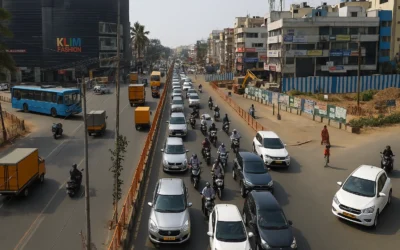In real estate, it’s simple to concentrate on the major figures, loans, taxes, and purchase price, but there’s a minor fee you should be aware of: Security for Interest-Free Maintenance (IFMS). Before a formal residents’ association is established, this one-time payment aids in maintaining the common areas on a property.
Even though you might not be immediately familiar with it, IFMS is essential to the efficient operation and maintenance of common areas in your new house. Consider it a necessary expenditure to keep the property functional and well-maintained, particularly at the beginning of ownership.
In this post, we’ll go over the importance of IFMS, its operation, and how it might impact your experience as a property owner.
What is IFMS? Full-Form & Meaning in Real Estate
First things first: Interest-Free Maintenance Security is the full name of IFMS.
When the buyer takes possession of the property, they pay the developer a one-time deposit. Consider it a safety net that guarantees your building or community will stay intact until the Residents’ Welfare Association (RWA) assumes responsibility for maintenance.
In real estate, IFMS is simply a cash reserve set up up front for the upkeep and efficient operation of common areas and shared services like lobbies, parks, elevators, security systems, and lighting.
Why is IFMS Charged?
Well asked. Think of relocating to a recently constructed apartment building. Who makes sure the water pumps function, the security guards are paid, and the elevators are in perfect working order while you’re still getting settled in?
Maintaining operations is the builder’s responsibility until a formal RWA takes over. They do this by collecting IFMS costs from every buyer.
In summary, it is funds that have been pre-collected and used only for the upkeep of shared infrastructure.
How Much are IFMS Charges Typically?
The super built-up area of your unit is typically what determines the IFMS charges. They are computed in terms of square feet. For instance, you will pay Rs. 50,000 as IFMS if the developer sets the rate at Rs. 50 per square foot, and your apartment is 1,000 square feet.
Always read the fine print because these fees can differ between developers and areas.
What is IFMS Used For?
Your IFMS payment isn’t just sitting in a vault somewhere. It goes into a maintenance reserve used to cover essential society services:
- Upkeep of elevators and electrical systems
- Water supply and plumbing
- Cleaning of common areas
- Landscaping and gardening
- Security staff salaries
- Repairs of common facilities
Until the RWA is officially formed, the builder uses these funds to handle these responsibilities.
Why is IFMS Necessary in Real Estate?
Realizing the significance of IFMS requires an understanding of its necessity. So, let’s explore it:
Ensures Immediate Maintenance of Common Areas
You don’t want to arrive at your new home to find the grounds neglected or the elevators broken. In order to maintain these vital areas in operational condition, IFMS helps ensure that maintenance personnel are hired right away.
Temporary Alternative to Residents’ Welfare Association (RWA)
Depending on the developer and location, the RWA, which is in charge of overseeing the building’s maintenance and other issues, is usually established a few months or even years later. In the meantime, IFMS makes sure that the maintenance services are uninterrupted.
Developers’ Financial Security
For developers, it also provides financial stability. The IFMS deposit enables them to pay for maintenance expenses without requiring prompt contributions from residents, as they are in charge of overseeing the property until the RWA is established.
Facilitates a Smooth Transition to Maintenance -Controlled Maintenance
Until the RWA assumes management, the IFMS deposit serves as a stopgap. It offers a smooth transition so that maintenance can go on uninterrupted.
Legal Framework Around IFMS
Thanks to the Real Estate (Regulation and Development) Act, 2016 (RERA), IFMS now has a legal backbone. According to RERA:
- Developers must mention IFMS charges in the sale agreement.
- Builders must transfer the maintenance responsibilities and the remaining IFMS to the RWA after its formation.
- Misuse or non-transfer of IFMS can lead to legal penalties.
This brings much-needed clarity and protects homebuyers from arbitrary charges and prolonged builder control.
How Are IFMS Charges Calculated?
The developer, project location, and property type can all affect the IFMS computation, which is typically simple. The charges are typically calculated as follows:
Using Square Footage
IFMS is typically computed as a set sum per square foot of your property. For instance, a maintenance fee of ₹10 or ₹20 per square foot might be charged by the developer. Therefore, your total IFMS charge would be ₹15,000 if your unit is 1,000 square feet and the rate is ₹15 per square foot.
Depending on the Property Type
Because common amenities like pools, gyms, landscaped gardens, and clubhouses require a lot of upkeep, IFMS fees may be higher in upscale or luxury complexes. In these situations, developers might raise the price per square foot to guarantee good upkeep of the property.
Fixed Costs for Specific Amenities
The developer may charge a fixed price for some developments, such as ₹50,000 or ₹1 lakh for residences with upscale amenities, depending on the kind of amenities offered.
Project Specifications and Location
Because it is more expensive to maintain premium services in metro areas or other high-demand places, properties in these areas may have higher IFMS prices.
Difference Between IFMS and Maintenance Charges
While they sound similar, they serve different purposes:
| Aspect | IFMS | Maintenance Charges |
| Payment Type | One-time | Recurring (monthly/quarterly) |
| Purpose | Reserve fund until RWA takes over | Day-to-day upkeep |
| Refundable? | No | No |
| Collected By | Builder | Builder or RWA |
Understanding the difference helps you plan your finances better and know what you’re paying for.
How to Verify IFMS Charges Before Paying?
Details to Verify: Buyers should make sure they obtain a thorough breakdown from the builder or developer before agreeing to pay IFMS charges. This breakdown should outline which services (such as security and common area upkeep) are covered by the IFMS, how the fees are determined (like per square foot), and how long the fees are in effect.
Transparency Advice: Purchasers should also inquire about the procedure for any upcoming IFMS fee increases and whether any authorities (like RERA) are controlling or capping these increases. Maintaining openness helps prevent unpleasant surprises or unanticipated costs later on.
Common Issues with IFMS
While the idea of IFMS is sound, execution sometimes isn’t perfect. Here are some common concerns:
- Delayed Transfer to RWA: Some builders delay handing over IFMS to the RWA, leading to friction.
- Lack of Transparency: Residents are often in the dark about how the funds are being used.
- No Standardization: Rates vary widely, and there’s no government cap, which can lead to inflated charges.
To avoid such issues, always check whether your builder has a good track record of handing over the IFMS on time.
Buyer Checklist Before Paying IFMS
- Confirm the exact amount and rate per sq. ft.
- Check if it’s mentioned in your sale agreement.
- Ask for a detailed breakdown of what services it covers.
- Confirm when and how it will be handed over to the RWA.
Being proactive can save you from unnecessary confusion or disputes later.
Wrapping Up
Here you have it: a comprehensive PDF explaining the purpose of IFMS in real estate. Interest-Free Maintenance Security may seem like just another expense on your bill, but it’s essential to keeping your house and surroundings clean from the start.
Just keep in mind that this is not a price you’re ignoring. It’s a proactive move toward future communal living and property upkeep.
So you know exactly what you’re getting into the next time you see IFMS mentioned in your builder-buyer agreement.




